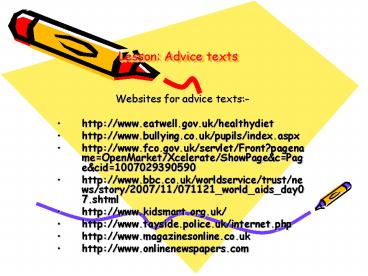Lesson: Advice texts PowerPoint PPT Presentation
Title: Lesson: Advice texts
1
Lesson Advice texts
- Websites for advice texts-
- http//www.eatwell.gov.uk/healthydiet
- http//www.bullying.co.uk/pupils/index.aspx
- http//www.fco.gov.uk/servlet/Front?pagenameOpenM
arket/Xcelerate/ShowPagecPagecid1007029390590 - http//www.bbc.co.uk/worldservice/trust/news/story
/2007/11/071121_world_aids_day07.shtml - http//www.kidsmart.org.uk/
- http//www.tayside.police.uk/internet.php
- http//www.magazinesonline.co.uk
- http//www.onlinenewspapers.com
2
Introduction Advice texts
- Teachers are advised to use examples of advice
texts to illustrate the presentational features,
organizational features and language features.
Please acknowledge all sources of any downloaded
document.
3
Presentational features
- 1) Short and attractive titles/sub-headings to
hook the audiences attention. - 2) Catchy captions for photographs to give
greater impact and effect
4
Presentational features
- 3) Layout Advice texts use the following
techniques - (a) Paragraphs? to organize the ideas in a
coherent fashion - (b) Bullet points? to highlight main
aspects/elements - (c) Range of font sizes and styles? for impact
- (d) Bold, italics, etc. ? for effect
- (e) Use of colour? to enhance appeal
- (f) Use of tables, charts and graphs ? to allow
easy understanding - (g) Photographs? to increase the appeal
5
Organizational features
- Range of punctuation
- Easy language
6
Language features
- Use of imperative verbs (do, look, etc.)
- Use of modals (should, could, might, etc.)
- Use of second person (you) /third person (s/he)
- Use of formal (polite and serious) /informal
(friendly) tone/mood - Use of formal (standard English) /informal
(non-standard English) language - Use of different sentences (simple sentence a
sentence with one idea compound sentence a
sentence with two ideas joined by a connective or
a comma and complex sentence a sentence with
one main clause/idea supported by subordinate
clauses/ideas) - Use of present tense (is, are)
- Use of connectives (but, and, because, after,
then, first, etc.)
7
Purpose of advice texts
- To suggest ways
- To recommend solutions and options
- To explain and inform
PowerShow.com is a leading presentation sharing website. It has millions of presentations already uploaded and available with 1,000s more being uploaded by its users every day. Whatever your area of interest, here you’ll be able to find and view presentations you’ll love and possibly download. And, best of all, it is completely free and easy to use.
You might even have a presentation you’d like to share with others. If so, just upload it to PowerShow.com. We’ll convert it to an HTML5 slideshow that includes all the media types you’ve already added: audio, video, music, pictures, animations and transition effects. Then you can share it with your target audience as well as PowerShow.com’s millions of monthly visitors. And, again, it’s all free.
About the Developers
PowerShow.com is brought to you by CrystalGraphics, the award-winning developer and market-leading publisher of rich-media enhancement products for presentations. Our product offerings include millions of PowerPoint templates, diagrams, animated 3D characters and more.

